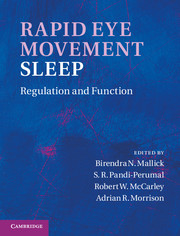Book contents
- Frontmatter
- Contents
- Contributors
- Preface
- Acknowledgments
- Organization
- Section I Historical context
- Section II General biology
- Section III Neuronal regulation
- Section IV Neuroanatomy and neurochemistry
- Section V Functional significance
- 30 Significance of deprivation studies
- 31 Modulation of body core temperature in NREM sleep and REM sleep
- 32 Sleep-related hippocampal activation: implications for spatial memory consolidation
- 33 The role of REM sleep in memory consolidation, enhancement, and integration
- 34 The role of REM sleep in emotional brain processing
- 35 REM-sleep loss, oxidative damage, and apoptosis
- 36 The role of REM sleep in maintaining neuronal excitability and its possible mechanism of action
- 37 Comparison of REM sleep-deprivation methods: role of stress and validity of use
- 38 REM sleep in patients with depression
- 39 Proteins and neuropeptides in REM-sleep regulation and function
- Section VI Disturbance in the REM sleep-generating mechanism
- Index
- Plate section
- References
39 - Proteins and neuropeptides in REM-sleep regulation and function
from Section V - Functional significance
Published online by Cambridge University Press: 07 September 2011
- Frontmatter
- Contents
- Contributors
- Preface
- Acknowledgments
- Organization
- Section I Historical context
- Section II General biology
- Section III Neuronal regulation
- Section IV Neuroanatomy and neurochemistry
- Section V Functional significance
- 30 Significance of deprivation studies
- 31 Modulation of body core temperature in NREM sleep and REM sleep
- 32 Sleep-related hippocampal activation: implications for spatial memory consolidation
- 33 The role of REM sleep in memory consolidation, enhancement, and integration
- 34 The role of REM sleep in emotional brain processing
- 35 REM-sleep loss, oxidative damage, and apoptosis
- 36 The role of REM sleep in maintaining neuronal excitability and its possible mechanism of action
- 37 Comparison of REM sleep-deprivation methods: role of stress and validity of use
- 38 REM sleep in patients with depression
- 39 Proteins and neuropeptides in REM-sleep regulation and function
- Section VI Disturbance in the REM sleep-generating mechanism
- Index
- Plate section
- References
Summary
Summary
Rapid eye movement sleep (REMS), first described by Aserinsky and Kleitman (1953), is a distinct state during sleep when the electroencephalographic (EEG) recordings appear similar to those observed during wake with low-voltage, high-frequency asynchronous activity, whereas the electromyographic (EMG) recordings, unlike wake, show lowest levels of muscle tone (muscle atonia), accompanied by rapid eye movements detectable by electro-oculographic (EOG) recordings. This paradoxical vigilant state combining wake-like cortical activation and inactive state-like muscle atonia with rapid eye movements has been extensively studied using animal model systems since the 1950s. Today much is known about the brain regions, neuronal networks, and neurotransmitters involved in REMS regulation (Fort et al., 2009; Jones, 2004; Luppi et al., 2006; McCarley, 2007). However, promising discoveries about the mechanisms depend on the identification of molecular processes that are involved in the transition and maintenance of different vigilant states, especially REMS, which is recognized for its brevity. The recent advances in molecular biology, instrumentation, and bioinformatics further extend novel opportunities to understand the mechanisms involved in REMS regulation and its function. Currently, no study has identified a single specific protein needed for REM generation or maintenance, but several proteins have been identified as changing either during REMS or following REMS deprivation, indicating their involvement in REMS. This chapter will begin with a brief review of the genomic and proteomic studies on sleep followed by a review of reports on REMS describing these different proteins, which include transcription factors, receptors, enzymes, and small peptides, and how they have contributed significantly towards the anatomical localization of REMS-associated brain regions and neurotransmitter phenotype of neurons, and toward a better understanding of REMS regulation and function.
- Type
- Chapter
- Information
- Rapid Eye Movement SleepRegulation and Function, pp. 395 - 402Publisher: Cambridge University PressPrint publication year: 2011



